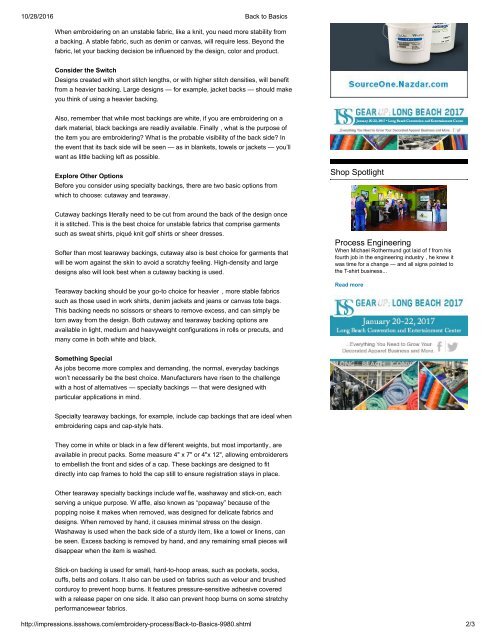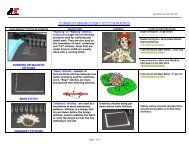Compiled Embroidery Skill Articles
Create successful ePaper yourself
Turn your PDF publications into a flip-book with our unique Google optimized e-Paper software.
10/28/2016 Back to Basics<br />
When embroidering on an unstable fabric, like a knit, you need more stability from<br />
a backing. A stable fabric, such as denim or canvas, will require less. Beyond the<br />
fabric, let your backing decision be influenced by the design, color and product.<br />
Consider the Switch<br />
Designs created with short stitch lengths, or with higher stitch densities, will benefit<br />
from a heavier backing. Large designs — for example, jacket backs — should make<br />
you think of using a heavier backing.<br />
Also, remember that while most backings are white, if you are embroidering on a<br />
dark material, black backings are readily available. Finally , what is the purpose of<br />
the item you are embroidering? What is the probable visibility of the back side? In<br />
the event that its back side will be seen — as in blankets, towels or jackets — you’ll<br />
want as little backing left as possible.<br />
Explore Other Options<br />
Before you consider using specialty backings, there are two basic options from<br />
which to choose: cutaway and tearaway.<br />
Shop Spotlight<br />
Cutaway backings literally need to be cut from around the back of the design once<br />
it is stitched. This is the best choice for unstable fabrics that comprise garments<br />
such as sweat shirts, piqué knit golf shirts or sheer dresses.<br />
Softer than most tearaway backings, cutaway also is best choice for garments that<br />
will be worn against the skin to avoid a scratchy feeling. Highdensity and large<br />
designs also will look best when a cutaway backing is used.<br />
Tearaway backing should be your goto choice for heavier , more stable fabrics<br />
such as those used in work shirts, denim jackets and jeans or canvas tote bags.<br />
This backing needs no scissors or shears to remove excess, and can simply be<br />
torn away from the design. Both cutaway and tearaway backing options are<br />
available in light, medium and heavyweight configurations in rolls or precuts, and<br />
many come in both white and black.<br />
Process Engineering<br />
When Michael Rothermund got laid of f from his<br />
fourth job in the engineering industry , he knew it<br />
was time for a change — and all signs pointed to<br />
the Tshirt business...<br />
Read more<br />
Something Special<br />
As jobs become more complex and demanding, the normal, everyday backings<br />
won’t necessarily be the best choice. Manufacturers have risen to the challenge<br />
with a host of alternatives — specialty backings — that were designed with<br />
particular applications in mind.<br />
Specialty tearaway backings, for example, include cap backings that are ideal when<br />
embroidering caps and capstyle hats.<br />
They come in white or black in a few different weights, but most importantly, are<br />
available in precut packs. Some measure 4" x 7" or 4"x 12", allowing embroiderers<br />
to embellish the front and sides of a cap. These backings are designed to fit<br />
directly into cap frames to hold the cap still to ensure registration stays in place.<br />
Other tearaway specialty backings include waf fle, washaway and stickon, each<br />
serving a unique purpose. W affle, also known as “popaway” because of the<br />
popping noise it makes when removed, was designed for delicate fabrics and<br />
designs. When removed by hand, it causes minimal stress on the design.<br />
Washaway is used when the back side of a sturdy item, like a towel or linens, can<br />
be seen. Excess backing is removed by hand, and any remaining small pieces will<br />
disappear when the item is washed.<br />
Stickon backing is used for small, hardtohoop areas, such as pockets, socks,<br />
cuffs, belts and collars. It also can be used on fabrics such as velour and brushed<br />
corduroy to prevent hoop burns. It features pressuresensitive adhesive covered<br />
with a release paper on one side. It also can prevent hoop burns on some stretchy<br />
performancewear fabrics.<br />
http://impressions.issshows.com/embroideryprocess/BacktoBasics9980.shtml 2/3




